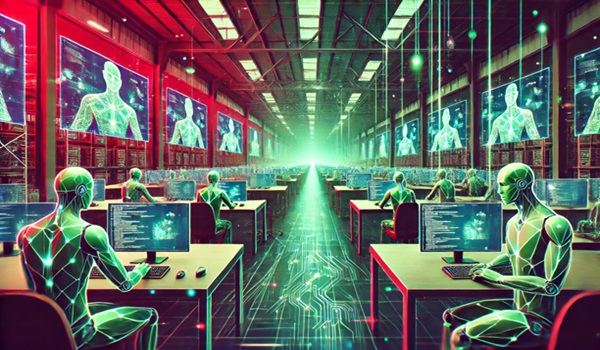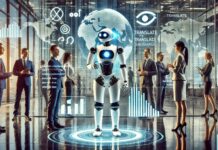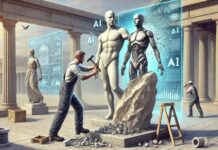Each week we find a new topic for our readers to learn about in our AI Education column.
Like most new technology, artificial intelligence is an accelerator. Unlike most technology, AI promises to accelerate the development of new technology itself—thus we come to the topic of AI-driven development, often referred to as AIDD but sometimes given the unfortunate abbreviation of ADD, which describes software development infuses with artificial intelligence throughout its lifecycle.
For most of the past five decades, various forms of computer code became the lingua franca of emerging technology. Whereas the world’s most important economic actors once had to master languages like French, English, Italian, Dutch or Spanish to navigate the centers of financial power, today, the same power and influence are tied up in the knowledge of JavaScript or C++ or Python or SQL, the programming languages upon which much of our software is built.
Thanks to AI, however, that knowledge is being democratized. Just as AI can help us accurately translate the past’s languages of trade like English or French, AI is also capable of reading, interpreting and writing JavaScript and SQL and virtually any other programming language.
How We Got Here
We were inspired by a Forbes article, A.I. Buzzwords: Top Artificial Intelligence Changes Reshaping Business, compiled by Forbes staff member Caleb King. King’s article takes a past-present-future approach to discussing AI, beginning with the 2022 launch of ChatGPT and following the subsequent rapid evolution of AI through mainstream adoption, an expanding ecosystem, workflow integration and the rise of agentic AI.
King them discusses new buzzwords that have arisen because of the advancement of AI, ideas like shadow AI, where employees launch their own personal AI agents and applications to automate and simplify tasks without official sanction or oversight; and AI governance, where companies are creating dedicated roles to mitigate AI risks and deal with implementation.
Among a list of development and infrastructure technology trends that includes AI moving beyond text prompts and a merger between software-as-a-service platforms and agentic AI (meaning SAAS businesses will just become AII agent platforms at some point), the Forbes author includes AI-driven development, saying, “you’ll see more devs using AI tools to build prototypes and baseline functionality faster, replacing traditional software approaches.”
But What is AIDD Really?
AI-driven development is the application of generative AI and large language models to the programming language of computers. It allows software developers—also called computer programmers—to automate large portions of their work, including generating ideas, accumulating information, scripting and editing code, and testing it.
Generally speaking, there are six stages to the software development lifecycle: plan, design, implement, test, deploy, and maintain. Developers may take different paths through these stages, like moving through them sequentially, sometimes called the waterfall approach, or a more cyclical, iterative approach where an application is released in a limited form, with new enhancements launched over time in successive versions.
AI can be used at any point in the process. In planning, AI can help sift through a business’s data so that decisionmakers can identify areas where new software has the most potential to produce long-term benefits. It can help transform those ideas into instructions for developers to build software, and it can also then generate, complete, edit or suggest code to fulfil those instructions, moving through the process to debugging and testing the new software.
It’s More Than Generating Ideas and Code
Building software can be a resource-intensive task, involving several project managers to handle scheduling and resource management and to liaise between developers and their clients. AI can handle many of these tasks, including tracking and providing accurate time estimates to clients.
As software is built and code is edited, artificial intelligence can automatically write and edit the documentation that is associated with that software and translate it into several languages so that the documentation can be accessed by global users. Then, after the program is deployed, AI handle tasks like code auditing and ongoing threat detection to identify potential vulnerabilities and monitor for breaches.
Over time, an artificial intelligence can also optimize, customize and personalize software for different applications, businesses or individual users. AI can be used to create better and more personalized user interfaces based on ongoing data collection—as more users deploy the software, the more data the AI has to work with to optimize performance and experience.
What This Means For Information Technology
The value of being able to understand and write different computer languages is already on the decline. Software engineers no longer need to be tasked with writing code for dozens of hours a week. The all-night “hack-a-thon,” a phenomenon responsible for aiding the rise of many of today’s mega-cap technology companies, is becoming quaintly obsolete. The quasi-romantic idea of a houseful of techies hopefully coding their way to future wealth and success is dying a rapid death. Computer programmers are now more like project managers, orchestrating the more automated development of software.
We’re a long way away from being able to automate the entire software development process. As long as we need guardrails around AI, as long as we need some\one with knowledge and skill to go back and check the work of artificial intelligence, to guide and refine its outputs, software engineers will continue to be relevant. Who can say what will become of the project managers in the long-term? The current iterations of AI make the organization and communication skills of software development project managers far less valuable than they have been to date.
For non-tech businesses, on the other hand, AI-driven development potentially means acceleration and efficiency. The cost of developing bespoke enterprise software should decline as it takes fewer people to produce and deploy a product. Deployment of new technology will be simplified and more automated than it has been in the past. The ease and lower cost of developing and implementing AI solutions could enable a new generation of entrepreneurs who won’t have to hire a computer science graduate to build the next killer app. The world is definitely changing!







